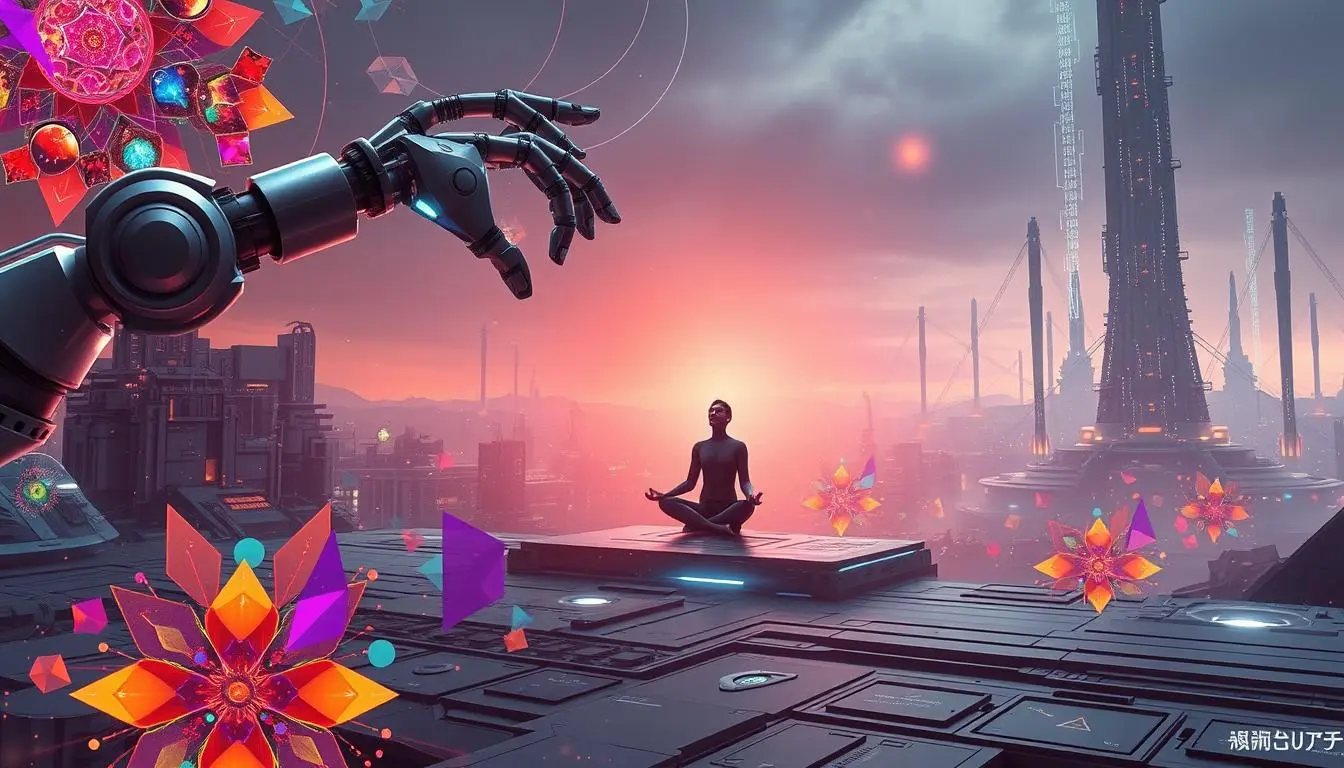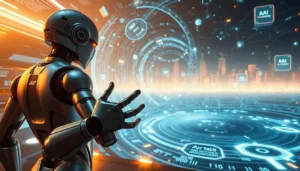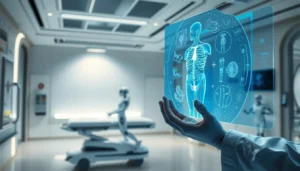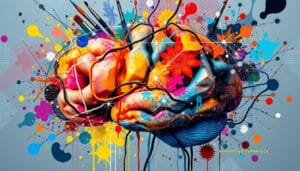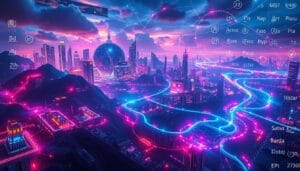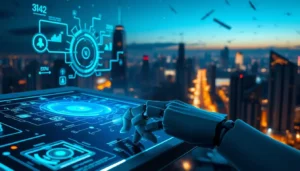AI vs. Human Creativity: Can Machines Really Be Creative?
You’ve probably thought that creativity is a uniquely human trait, making us different from machines. But with the rise of “generative” artificial intelligence, this idea is being questioned.
Picture a machine that can make original art, music, or write a great story. It feels like a concept straight out of a futuristic novel, doesn’t it? Yet, today, we’re seeing this become a reality. The ability to create has always been a key human trait. But new tech is making us wonder if machines can be creative too.

As you learn more about these technologies, you’ll see that the real question isn’t if machines can be creative. It’s more about how their creativity stacks up against ours.
Table of Contents
Exploring Creativity: Human Intuition vs. Machine Logic
The mix of human creativity and machine learning is really interesting. It shows us what creativity means today. We need to know how humans and machines are different in creative tasks.
What Makes Human Creativity Unique
Human creativity is all about imagination, emotions, and personal stories. It’s making new links between things that don’t seem related. This comes from subconscious intuition and deeply ingrained cognitive processes.
Our ideas and imagination start from making connections. We see, hear, feel, or learn something. Then, we form an idea or opinion.
How AI Approaches Creative Tasks
Generative AI employs deep learning models to process and extract meaningful patterns from massive data pools. This lets AI create new stuff like images, music, or text. It does this by following patterns and structures it’s learned.
The table below shows how human and AI creativity are different.
| Aspect | Human Creativity | AI Creativity |
|---|---|---|
| Source of Inspiration | Experiences, Emotions, Intuition | Large Datasets, Algorithms |
| Creative Process | Intuitive, Subconscious | Computational, Rule-Based |
| Output | Novel, Often Unpredictable | Generated based on Patterns |
Knowing these differences helps us see the strengths of both human and machine creativity. They can work together in many creative areas.
The Evolution of AI Creative Capabilities
The creative potential of AI has undergone a dramatic transformation in recent years. This progress is driven by breakthroughs in computational power and innovative algorithmic approaches. Artificial intelligence (AI) has made big strides in speech, picture recognition, machine learning, and natural language processing.
These advances have changed the creative world. Now, machines can do tasks once thought only for humans.
From Rule-Based Systems to Neural Networks
Early AI creativity emerged from rigid, predefined rule structures. These systems followed set rules to make content. But, they couldn’t create new or original things.
The move to neural networks was a big change. Neural networks learn from lots of data and make complex, original content. Now, AI can transcend mere procedural execution, generating novel outputs. It can now show creative innovation and digital creativity that we never thought possible.
Modern AI Creative Tools and Platforms
Now, you can use many AI creative tools and platforms. They’re changing how we work in creative fields. Platforms such as ChatGPT and Dall-E have popularized AI-generated media, spanning text, visuals, and multimedia compositions.
These tools use neural networks to make high-quality, creative work. Often, it’s hard to tell if it was made by a human or AI. AI has seamlessly integrated into artistic workflows as a collaborative force. It enhances human potential while pioneering uncharted avenues in digital expression.
As AI keeps getting better, we’ll see even more advanced tools. They will make the difference between human and machine creativity less clear.

AI vs. Human Creativity: Core Distinctions and Similarities
When we compare AI and human creativity, we see both differences and similarities. These are mainly in originality and intentionality. Creativity involves synthesizing original concepts with meaningful impact. But humans and machines take different paths to get there.
Humans possess an innate capacity for abstract thought and conceptual innovation. This comes from their experiences, feelings, and understanding of complex situations. AI, even the most advanced, creates content based on patterns and data it’s been trained on.
Originality and Novelty Comparisons
AI can mix existing elements in new ways, but it’s limited by its training data. Humans, though, can introduce completely new ideas not seen before. The main differences are:
- AI sticks to what it’s learned.
- Humans can go beyond their experiences.
- AI’s originality stems from recombining existing knowledge rather than true invention.
Intentionality and Purpose
The role of intentionality in creativity is key. Humans create with a clear purpose, driven by their experiences, feelings, and goals. AI, while it can mimic creativity, doesn’t have personal intent or emotions.
Here are the main points about intentionality:
| Aspect | Human Creativity | AI Creativity |
|---|---|---|
| Intentionality | Driven by personal goals and emotions | Operates based on algorithms and data |
| Purpose | Guided by human values and context | Directed by programming and objectives |
In summary, AI and human creativity both produce amazing results. But their ways of working and what drives them are very different. Knowing these core distinctions and similarities helps us see the special value each brings to creativity.
The Technical Foundations of AI Creativity
Cognitive computing is key in making AI systems creative. You’re seeing a big change in how machines create content, from art to music. This is thanks to complex algorithms and huge datasets.
How Generative Models Work
Generative AI employs ML models to extract patterns from extensive data repositories. These algorithms help AI create new content that looks like it was made by humans. These systems identify and replicate trends within their training datasets.
Leading-edge frameworks like GANs and VAEs excel at producing lifelike visuals, compositions, and narratives. After training on datasets, these systems generate fresh content by extrapolating learned structures.
Limitations of Current AI Creative Systems
Even with progress, AI creative systems have their limits. Their performance heavily relies on the richness and diversity of input data. If the data has biases, the AI’s output might be biased too. Also, if the data isn’t diverse, AI’s creativity can be limited.
AI can make new content, but it doesn’t have the intentionality and purpose of a human creator. Knowing these limits is important for using AI in creative areas.
AI Creative Achievements Across Industries
AI has revolutionized creative industries, pushing the boundaries of artistic and technological innovation. It’s changing how we do creative work, making it better with AI’s help. This is true across many industries.
Visual Arts and Design
In visual arts and design, AI is making amazing new visuals. It can create textures, colors, and shapes we never thought of before. Generative adversarial networks (GANs) are amazing at making images that look just like human art.
This is big news for graphic design, architecture, and fine arts. Designers can now try out new ideas with AI’s help. It makes their creative work even better.
| Industry | AI Application | Benefits |
|---|---|---|
| Graphic Design | Automated generation of design elements | Increased efficiency, novel design options |
| Architecture | Procedural modeling of buildings and landscapes | Enhanced creativity, reduced design time |
| Fine Arts | Generation of new art styles and forms | Expansion of artistic expression |
Music and Sound Design
AI is also changing music and sound design. It can come up with new melodies and harmonies. Amper Music is a great example of AI helping artists make music.
In music production, AI accelerates workflows and introduces unconventional sonic landscapes. It looks at lots of music to find new ideas and patterns.

Writing and Narrative Creation
In writing and storytelling, AI is helping create content. It can make news articles and stories. AI tools learn from lots of text and make stories that fit right in.
While AI-generated writing still has room for refinement, its capabilities are rapidly evolving. It can help with marketing, journalism, and even teaming up on stories.
The Human Creative Advantage
Human creativity has a unique edge that AI systems can’t match. This is because of your experiences and cultural background. AI has made great progress in creating content, but human ingenuity has its own unmatched qualities.
Cultural Context and Lived Experience
Your experiences and cultural background shape how you connect new ideas. This cultural context brings unique meanings and understanding to human creativity. For example, a musician inspired by their culture can create music that deeply resonates with others.
Your life experiences, shaped by your environment and personal history, add richness to your creativity. AI systems, with their algorithms, can’t match this depth and nuance. This doesn’t mean AI can’t create impressive work, but the depth comes from human experiences.
Intuition and Subconscious Processing
Intuition and subconscious processing are key to human creativity. You often create without thinking through every step. Your subconscious mind helps make new connections and ideas that might not be easy to explain.
This intuitive part of creativity is linked to your ability to innovate and explore new boundaries. While AI can process lots of data, it lacks the subconscious insight humans have. This intuitive leap is a key part of human creativity.
To understand the distinction between human and AI creativity, we must first define human originality. It’s not about saying AI is bad, but recognizing the unique strengths humans have in creativity.
Collaborative Human-AI Creative Partnerships
The mix of human creativity and AI is creating new ways to express ourselves. As you dive into AI’s role in creative tasks, you’ll see it’s more than just a tool. It’s a partner that can boost and change your work.
Using machine learning algorithms and artificial intelligence, creatives can tap into a world of new ideas. AI can sift through huge amounts of data, spot patterns, and come up with fresh ideas that humans might miss.
AI as Creative Assistant and Amplifier
AI can help in many ways during the creative process. It can do boring tasks, offer ideas from big datasets, and even start drafts or ideas. This lets human creatives work on the big ideas and make AI’s suggestions better.
In graphic design, AI can make many layout options based on certain rules. This lets designers focus on the creative vision and tweak AI’s ideas. In music, AI can help with background scores or melodies, based on what the composer wants.

Case Studies of Successful Collaborations
Many projects show how well humans and AI can work together. For example, the AI-made portrait “Edmond de Belamy” by Obvious sold at Christie’s for $432,500. It shows AI can create art that people love.
In screenwriting, AI can analyze hit films, detect narrative trends, and propose fresh plot developments. This helps human writers in their work.
These examples show that the future of creativity is in working together with AI. By teaming up, you’re not just getting better at creating. You’re also leading the way into a new era of innovation.
Ethical and Philosophical Implications
AI can now make complex art, music, and literature. This makes us think about the ethics and philosophy of machine creativity. As AI makes more advanced works, we must ask about legal rights and protections for these creations.
Who owns AI-generated works is a big question. Should these works have the same rights as those made by humans? This conundrum forces us to reconsider long-held beliefs about who or what can claim creative rights.
Ownership and Attribution Questions
There’s no clear law on who owns AI-generated works. We must decide if the AI creator, the user, or the AI itself owns the work.
- The AI creator might own it, as they made the tool.
- The user who prompts the AI could also own it, as their input shapes the work.
- Or, the AI itself could be seen as the creator, leading to new questions about machine rights.
Economic Impact on Creative Industries
AI creativity also has big economic effects. As AI content grows, it could shake up traditional creative fields, possibly replacing human jobs.
Key areas of impact include:
- Art and design, where AI visuals and graphics might reduce demand for human artists.
- Music and sound design, where AI music could change the role of composers and musicians.
- Writing and narrative, where AI content could impact authors and journalists.
To lessen these effects, we need new laws and rules for AI content. This includes updating copyright laws, setting clear ownership and attribution rules, and helping workers in creative fields who might lose their jobs to AI.
By tackling these issues, we can create a future where human and AI creativity work together. This will lead to creative innovation and better digital creativity.
The Future of AI vs. Human Creativity
The future of creativity will blend human ideas with AI’s power. As AI gets better, what we call “creative” will change.
New technologies will change AI’s creative abilities. These include:
- Advanced Generative Models: Future AI might use smarter models to make new, realistic content.
- Multimodal Learning: AI could learn from text, images, and audio, making it more creative.
- Cognitive Architectures: Adding cognitive architectures to AI might help it understand and mimic human creativity.
Emerging Technologies and Their Creative Potentials
New tech promises to boost AI’s creativity. Cutting-edge AI models, for instance, can produce hyper-realistic visuals and dynamic video sequences. By integrating multimodal learning, AI can synthesize and analyze diverse media formats in unison.
Predictions for Creative AI Development
AI will play a bigger role in creativity soon. We might see AI tools that work with humans, sharing ideas to boost creativity. The line between human and AI creativity will keep getting blurred.
As AI grows, we’ll see new kinds of creativity from human-AI teams. This could lead to big breakthroughs in art, music, writing, and design.
Conclusion: Embracing a New Creative Paradigm
AI is changing how we create, making machines as good as humans at art, music, and writing. This shift in cognitive computing is making us rethink what art and expression mean.
Now, humans and machines work together to make new, innovative things. By accepting this change, you can explore new ways to be creative and solve problems.
The future of creativity is about combining human ideas with AI’s power. As you explore this new world, you’ll find ways to use cognitive computing to boost your creativity.

